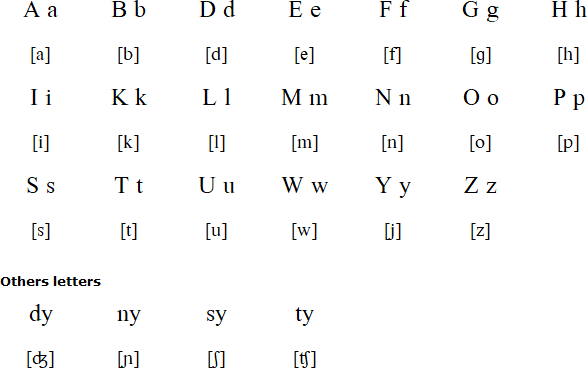Ndyuka is an English-based creole spoken in parts of Suriname and French Guiana by about 67,000 people. In Suriname it is spoken in east of the country in the districts of Brokopondo, Commewijne, Marowijne, Para and Sipaliwini. In French Guinana it is spoken in the Cayenne islands, and along the border with Suriname.
The language is also known as Aukaans, Ndjuká, Ndyuka tongo, Nenge, Nenge Tongo, Nengee Tongo, Njuká or Okanisi.
Ndyuka uses mainly English vocabulary, and some Dutch and Portuguese words as well. The grammar and pronunciation have influences from a number of West African languages.
There are two ways to write Ndyuka with the Latin alphabet: an old Dutch-based orthography and a modern English-based one, which was first proposed in 1984. However, few people are able to read and write their language. It is used to some extent in religious literature and services, and on the radio in Suriname, and is taught in primary schools in French Guiana.
There is also a script for Ndyuka known as the Afaka Syllabary, which was invented by Afaka Atumisi in Suriname in 1908 as a way to write Ndyuka. It is rarely if ever used these days.

Download a script chart for Ndyuka (Excel)
En so den be abaa na a líba, dísi wi kai Kawína Líba. Di den abaa de, den abaa teke gwe na opu fu Kawína. En so den be waka langa langa gwe te na Mama Ndyuka ede, pe wi kai Mama Ndyuka.
And so they crossed the river, which we call "Kawina [Commewijne] River". Having crossed it, they went way upstream along the Commewijne. Thus they travelled a long, long way, clear to the upper Tapanahony, the place we call "Mama Ndyuka".
Source: https://en.wikipedia.org/wiki/Ndyuka_language#Example
Information about Ndyuka | Afaka Syllabary | Numbers
Information about Ndyuka
https://en.wikipedia.org/wiki/Ndyuka_language
https://suriname-languages.sil.org/Aukan/Aukan.html
https://www.101lasttribes.com/tribes/ndyuka.html
https://www.encyclopedia.com/humanities/encyclopedias-almanacs-transcripts-and-maps/ndyuka
http://www.language-archives.org/language/njt
https://www.sil.org/resources/search/language/njt
Betawi, Bislama, Cape Verdean Creole, Chavacano, Chinook Jargon, Dominican Creole French, Fanagalo, French Guianese Creole, Guadeloupean Creole, Guinea-Bissau Creole, Haitian Creole, Jamaican, Kituba, Manado Malay, Mauritian Creole, Nagamese, Ndyuka, Norfuk, Nubi, Palenquero, Papiamento, Pijin, Réunion Creole, Sango, Saramaccan, Seychelles Creole, Sierra Leonean Creole, Singlish, Sranan, Saint Lucian Creole, Tok Pisin, Torres-Strait Creole
Languages written with the Latin alphabet
Page last modified: 13.10.24
[top]
You can support this site by Buying Me A Coffee, and if you like what you see on this page, you can use the buttons below to share it with people you know.

If you like this site and find it useful, you can support it by making a donation via PayPal or Patreon, or by contributing in other ways. Omniglot is how I make my living.
Note: all links on this site to Amazon.com, Amazon.co.uk
and Amazon.fr
are affiliate links. This means I earn a commission if you click on any of them and buy something. So by clicking on these links you can help to support this site.
[top]